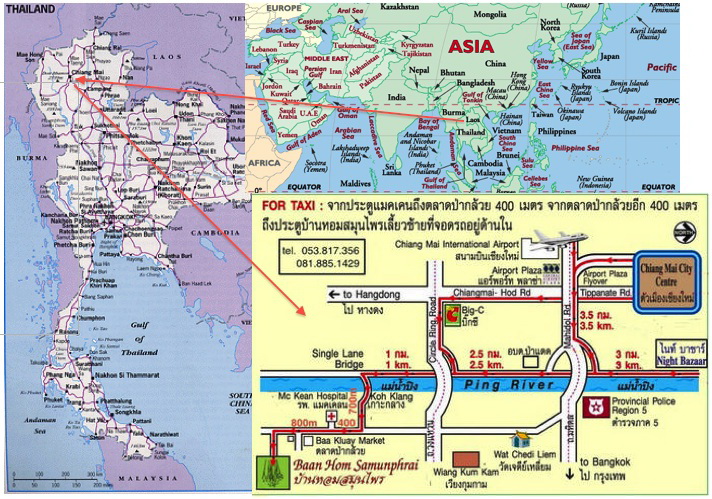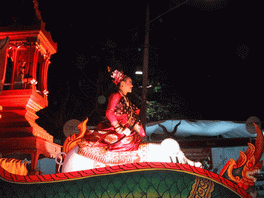|
Baan Hom Samunphrai A Herbal Health Centre & School Chiangmai, Thailand |
||
|
Address: Baan Hom Samunphrai 93/2a Moo 12 Tawangtan, Saraphi, Chiang Mai 50140, THAILAND tel. 053-817-362
(English & Thai) tel. 081.885.1429 (Homprang direct)
---------INDEX---------
---------INDEX---------
Address: Baan Hom Samunphrai 93/2a Moo 12 Tawangtan, Saraphi, Chiang Mai 50140, THAILAND tel. 053-817-362
(English & Thai) tel. 081.885.1429 (Homprang direct)
---------INDEX---------
Address: Baan Hom Samunphrai 93/2a Moo 12 Tawangtan, Saraphi, Chiang Mai 50140, THAILAND tel. 053-817-362 (English & Thai)
tel. 081.885.1429 (Homprang direct) |
Click on the map above for a print-out for your driver. WHERE WE ARE IN SOUTH EAST ASIA - Dec. 10th, 2024. Chiang Mai is one of the most intriguing cities in the whole of South Asia. Located in the foothills of the Himalayas at the meeting point of Thailand, Burma and Laos, this remote 'Shangri-La' is justly famous for its fresh climate, dramatic scenery, vibrant ethnic complexity, exotic rituals, and extraordinary sense of fun. Our Centre, Baan Hom Samunphrai, is only 9 kms from the Chiang Mai city centre, and that means the full range of its wonders are easily available to our students, clients, guests and conference groups. Moving in the opposite direction is easy too, as we're only an hour away from unspoiled hill-tribe settlements, mountain torrents and real jungle. Finally, we're not only just 15 minutes from the Chiang Mai International Airport, with direct connections all over the world, but at the end of one of the last great Adventure Train Rides left in the world--the snail-pace Bangkok-Chiang Mai Express! (You can Click Here for a Google Map of Chiang Mai.) SMART PHONES: Every Taxi driver in Chiang Mai now has a Smart Phone. Just show 'BAAN HOM SAMUNPHRAI' on your own phone and he will deliver you here in 15 to 20 minutes -- or pick you up from our gate, day or night. Rarely takes more than 5 minutes for a car to arrive, and costs about 200 Baht either way. Hill Tribe women selling handmade silver These hand-woven skirts can still be seen There is a festival almost weekly in Chiang Mai with Our small village of Hang Quae (rhymes with 'air') still relies upon agriculture for its livelihood. There are rice paddies, longan orchards, vegetable gardens, irrigation canals and fish ponds all around us, and herbal medicine is still used widely by our neighbours. We ourselves grow most of the herbs we use in our garden, and the fruit we serve at our tables is either picked from our own trees or brought home early in the morning from the village earth market. Walks and bicycle rides are a delightful way to explore the countryside, and we have a whole fleet of bicycles for our guests. You push your bicycle through our back gate and over the irrigation canal to get started. The buffalo have just finished grazing and are settling down in the mud to chew their cuds. Faithful and tireless workers, the Thai water buffalo is among the most contented creatures on earth, especially when unemployed!
Homprang's husband, Christopher, introduces some guests to the ancient Kingdom of Lanna, "Land of a Million Rice Fields," with its blue hills and electric green rice. The farmer on the right has just dug up some turmeric for a new mother in the village, and Smokey Lyons from Vermont can't believe his nose -- and it's also a very important herb in our steam baths!
Here's a recent photo taken by Katja Mögler during a bicycle ride in the monsoon rice at the very end of the special Refresher Course for professionals we held here last August. (You can click on her name to see Katja at work in her studio back in Halle near Berlin.) Maw Hom is assisted by her husband, Christopher Woodman--you can click on his name for a bit more about him. He's fascinated by the local Thai community, and if you ask him will lead you into it anytime, on foot or by bicycle--the river, the rice paddies, the ruins, wats, sacred groves, graveyards & spirit houses. This is what Christopher says about Katja's photo above: "The rice is most beautiful in the monsoon light like this. It rains extremely hard from June through October for 20 minutes or so everyday, then the sun comes out with rainbows that arc across the sky -- and you can see all the way to the Burmese mountains, the air is so clear and fresh much of the time. The kapok tree in the center of the photo is one of my favorites. It loses all its leaves in the dry season in February, like so many tropical trees, then bursts into bright red flowers a few weeks later when it looks most dead. The petals are gathered up everywhere and dried to make kaeng khae, the delicious spicy noodles everybody so loves. Then a few months later the green fruit-pods split open and the ground is covered in kapok as white as snow -- all our Baanhom mattresses are filled with it. But be careful of the thorny knobs on the trunk of this tree -- according to Thai legend, the unfaithful must shinny up and down it naked forever and ever in hell!"
The film was shot during a single afternoon, and stars just whoever happened to be there at the time. The old crank-up gramophone was brought by a Norwegian friend -- the last one out of the steam bath smiling sheepishly at the camera. The fire is what we have every evening in December and January. All the rest is what happens any time of the year.
. FLIGHT, ARRIVAL & DEPARTURE INFORMATION
|










.jpg)










